If further proof was necessary (and it really wasn’t) that I should stay off Amazon late at night, it came a week or so ago when I decided I needed to order the new Columbia Hammer Horrors collection in order to get The Gorgon. In itself, that’s no big deal, but Amazon has this business about “you may also be interested in” and promises of free shipping if you spend a little more money. (The absurd thing about the latter is that I almost never take the free shipping and the few days delay that comes with it.) So I started scouting around — only to discover that a box set containing all 80 — yes, 80 — of the Hal Roach produced “Little Rascals” shorts for a mere 50-odd dollars had been released. Having long wanted to check out certain childhood favorites that have refused to show up in any of the distinctly willy-nilly single disc collections, I ordered the set without a moment’s hesitation. I don’t regret this, but it goes to show that I am appallingly weak-willed in these matters.
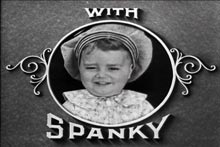
Most of us — at least those we call “of a certain age” — grew up on the Little Rascals on TV, which, by the way, is when they actually became the Little Rascals. That came about when Roach sold the shorts to television. The films were originally billed with the words “Our Gang Comedy,” followed by “Hal Roach presents His Rascals in” whatever the title of the film was. The first couple films in the set — Small Talk and Railroadin’ (both 1929) — were so pleased with themselves for being talkies, the titles read, “Hal Roach presents His Rascals’ Voices.” With Free Wheeling in 1932, the billing changed to “Our Gang in” and stayed that way, but when Roach sold the series (but not the films he produced) to MGM in 1938, he lost the rights to the name “Our Gang,” and so the Little Rascals name came into being in 1955. So entrenched is the name — especially among baby boomers — that the set is called The Little Rascals: The Complete Collection, which is also apt, since these are the films that made up the TV package.
The question, of course, is how do these old movies hold up? The answer is simply that they’re variable, but that needs a caveat in itself, because much depends on what you’re looking for here. The shorts change so much — as does the cast — over the years that it’s inevitable that fans are going to be more predisposed to certain blocks of films. When they think of the series, most people are probably thinking of the later period Our Gang shorts — the ones featuring Spanky (George “Spanky” McFarland), Alfalfa (Carl Switzer), Darla (Darla Hood) and Buckwheat (Billie “Buckwheat” Thomas) — which date from around 1936 through 1938. For purposes of dividing the films, however, it’s easiest to place them in two eras — the Robert McGowan period (1929-1933) and the later films with various directors (1933-1938). McGowan did direct one of the later films — Divot Diggers (1936) — and missed out on helming a few of the earlier ones. His participation dates back to the silent films (which are hard to come by these days) and he was — along with Roach — the architect of the original films.
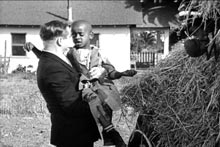
Personally, I’m a much bigger fan of the McGowan era. Or maybe I should say I’ve become one. When I was a kid, I was just as happy with the later films, many of which I now find close to unwatchable for various reasons, not the least of which is the fact that I’ve come to dislike Alfalfa and, to a lesser extent, the older Spanky (it remains to be seen if I’ll ever even play the last couple of discs in the set).
The McGowan films differ distinctly in that there’s a heavier reliance of improvisation and naturalism. The later films are slicker, more streamlined, more calculated — and, to a degree, lose the identity of the original series. For example, the late 1934 entry, Washee Ironee, while still a pretty good short, is directed by Laurel and Hardy expert James Parrott (brother of another Roach star, Charley Chase, whose real name was Charles Parrott), and it plays like a Laurel and Hardy film. The slapstick is similar and its climactic gag might have been lifted directly from the Stan and Ollie playbook. Less obvious changes come via Gus Meins and Gordon Douglas, but the off-the-cuff air is missing — as is McGowan’s odd blend of realism and fantasy.
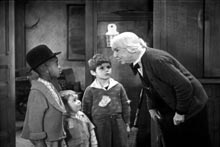
To a great degree, the earlier films may simply be different because of the era. They were mostly made during the worst of the Depression and they reflect that. They’re also pre-code films and like the Laurel and Hardy shorts and the Betty Boop and Popeye cartoons from that time, they’re blessed with a grubiness that’s not in keeping with post-code Hollywood where everything started looking nicer in keeping with the positive tone of the time. The earlier Our Gang films depict very real poverty and even hunger. The kids are often in orphanages or something very like them. In the 1933 McGowan helmed Mush and Milk, they’re in a positively Dickensian boarding school, lorded over by the movies’ most terrifying old woman, the twisted-faced Louise Emmons (probaby best known for “hag” bit parts in movies like Mark of the Vampire (1935). How bad is she? Well, she carries a whip.
The topics addressed in McGowan era films are also more daring — child abuse, divorce, over-protective mothers, abusive relatives all come into play. The plots are often standard — there are two instances of nice old ladies with villains out to defraud them — and they’re unabashedly sentimental in many cases (not invariably a bad thing). The tone, however, is another matter. The world of the McGowan films combines the sometimes painfully real world of the Depression with the casually fantastic. It’s a world where the frequently undeveloped streets of Culver City (where the Roach studio was) are filled with some pretty odd things. In Free Wheeling, for example, it would seem that monkeys must roam freely (monkeys often feature as pets — as do goats, mules, and even pigs) on those streets. In Bear Shooters (1930), bootleggers with their still hidden in the nearby woods have at their disposal a perfectly fine gorilla suit (courtesy of the movies’ best gorilla player, Charles Gemorra) that seems to exist for no reason other than to scare people away. (That the presence of a gorilla in a suburban area might draw attention occurs to no one.)
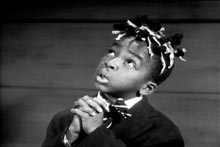
A few of the films are surprisingly serious in tone. The 1931 entry Little Daddy is built around the premise that Farina (Allen Hoskins) is about to lose “custody” of his little brother, Stymie (Matthew Beard), since the authorities have realized (the authorities are generally slow on the uptake in all Hal Roach pictures) that their father is in jail. It’s also interesting that this particular film focuses on Farina and Stymie (the short is more than half over before the rest of the gang make an appearance) in a way no other film does. The surprise, of course, lies in the fact that these are the black kids in the group, which brings us to a central issue that has plagued the films in recent years — whether or not they’re racist.
There are certainly racist elements in the films. That’s impossibile to deny. The very fact that Farina’s and Stymie’s father is in jail — for having a still, no less — makes that clear. (It’s also one of several instances where the black kids’ fathers are referred to be as being in jail.) And there’s the standard quotient of “scared black guy” humor in the films. However, it can also be argued that all the kids are stereotypes of one kind or another and that the formula required a mix of all kinds of kids in order to work.
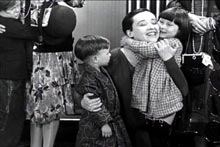
Moreover, there’s an element of situational realism to much of this. Take the first film in the set, Small Talk, in which Wheezer (Bobby Hutchins) has been adopted by a society woman (Helen Jerome Eddy) out of the orphanage that houses all the kids. Naturally, the others sneak out to visit him and they all end up being adopted by other society women at the end — all but Farina, who is politely turned down and reduced to tears because no one wants him. Is this racism or simply realism? Would a rich white woman adopt a black kid in 1929? No. That he is then adopted by the woman’s maid (Edith Fortier) softens the tone, while simultaneously exacerbating it with the maid’s, “Dry yo’ eyes, ‘cos I’se yo’ new mammy,” but even that is part and parcel of the time (ever read any of black writer Zora Neale Hurston’s books?) and there’s clearly no cruelty intended.
It’s absurd and counterproductive to attempt to judge films—or anything else—out of the context of their time frame (and it’s dangeous to try to pretend that earlier attitudes didn’t exist), and looked at in that light, the Our Gang films are actually surprisingly enlightened. They depict black kids going to school with white kids and as part of the gang itself. The issue of color is never even addressed in and of itself. This is even true of most—not all —of the adults in the films. Granted, Dickie’s (Dickie Moore) mother (Lillian Rich) expresses something like outright horror at the prospect of her son playing with Stymie, referring to him as “that colored boy,” but this is more the exception than the rule. In the same film, Dickie’s father (Creighton Hale) has no problem with it and even holds Stymie in his arms at the end of the short.
Similarly, check out Moan & Groan, Inc. (1929)—a film that comes under different charges of racism owing to the presence of then-popular Jewish comedian Max Davidson as a lunatic inhabiting a “haunted” house. Davidson’s Yiddish schtick may seem a bit much now, but there’s also Edgar Kennedy as the neighborhood cop, who is happy to babysit Farina’s baby brother, so Farina can play with the gang. There’s even a gag predicated on the existence of racial inequality when Kennedy changes the baby’s diapers and looks disapprovingly at a can of talcum powder labeled “flesh colored.” This doesn’t evince anything like a racist attitude on the part of the films. On balance, the films are actually a breakthrough.
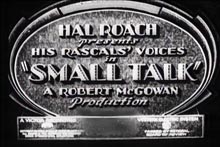
Despite the realistic quality in the McGowan era films, it’s a mistake to view the films as some sort of accidental documentary of what it was like to be a kid in a roseate colored past. There’s a bit of truth in that, but it doesn’t factor in the very real downsides of poverty and lurking poverty that hovers over the films. Beyond that the films themselves present a somewhat fantasticated world of childhood — a sense of “wouldn’t it have been neat if when we were kids” clings to the films. In many way, it’s an adult’s fantasy of what they might have wished their own childhood was like. It’s not for nothin’ that the Leroy Shields’ “Little Rascals’ Theme” is actually titled “Good Old Days.” It evidences an adult nostalgia for a childhood that never really existed.
What’s perhaps most interesting about having the films in a chronological set is the ability to at last see them in order and watch their evolution. The earliest films —‚ whatever their charms — are clunky in the manner of a lot of early talkies. The lack of a background score prior to When the Wind Blows (1930) makes them even creakier. The background scores we associate with the series — and in many cases with all the Roach product from that era — crop up even later, and even though it’s been grafted onto Lazy Days (1929) in this set, evidence shows that the “Good Old Days” theme wasn’t actually used till Teacher’s Pet (1930). It’s often difficult to trace these things because music has in many cases been added a later date. Some early Laurel and Hardy shorts now boast scores that use music that wasn’t written till several years later. In the case of Lazy Days, it seems improbable that the theme would crop up and then be replaced on the next few shorts with “Running Wild” and other pieces.
The shifting of players is also interesting to follow. The addition of Jackie Cooper was certainly a bonus, but he was on his way to bigger things by 1931 when Paramount snatched him up for the lead in the feature Skippy. Often a replacement player — like Stymie replacing Farina — would start out in a minor capacity, only coming into the foreground when the original player outgrew the role — a factor in the continued success of the series that got lost in the post-McGowan era.
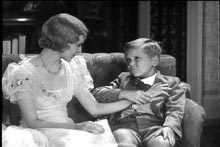
In 1932 a film called Free Eats — an intriguing variant on The Unholy Three — introduced a new character, Spanky. Ironically, this is one of the few films of that era not directed by McGowan (the lackluster Ray McCarey — less talented brother of Roach alumnus Leo McCarey — handled the chore). Spanky was an immediate hit. By the next entry, Choo-Choo! (1932), Spanky received unheard of special billing apart from the gang. This was followed by a film actually titled Spanky (1932). What followed was both a blessing and a curse. There’s no question but that Spanky was a natural and his appeal was obvious. He had the gravity of a diminutive Oliver Hardy (and like Hardy would sometimes look at the audience in a mute appeal for our sympathy) and he brought much to the films. The problem was he brought so much that the idea of replacing him when he outgrew the role became unthinkable. This would occur again with Alfalfa and it’s part of the reason why the later films seem stale and ultimately even phony.
The signs of rot that set in with the final Roach films became unbearable after the series was sold to MGM. Blessedly, these are not a part of the set. The kids became MGMed out of existence into typical middle-brow MGM product — sanitized beyond recognition with bland patriotic and civic responsibility themes slapped onto the movies in the sanctimonious way that only Louis B. Mayer could provide. There was a certain appealing anti-authority anarchy to the earlier Roach films. A film like McGowan’s The Pooch (1932) in which the villain is a heartless dogcatcher (Budd Fine) who tries to gas Stymie’s dog — Pete the Pup, of course — out of revenge and without giving Stymie the chance to pay the five dollar license fee would have given Mayer apoplexy. You’ll find nothing like it in the MGM productions.
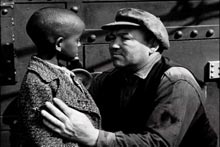
Indeed, you’ll find nothing of merit in those last films — apart from the overgrown leads looking rather foolish. Even the production values (a supposed trademark of MGM) are lacking. There are moments in the Roach films when the kids will obviously look in the direction of the camera for guidance from the director, but nothing like some of the amazing ineptitude on display here. There’s even one in which one of the kids — a newcomer — has not only memorized her lines, but everyone else’s. The problem is she mouths everyone’s dialogue while waiting for her turn. That this wasn’t reshot testifies to how little value MGM placed on the series in its waning days.
But enough of the downsides of what came at the end, all in all this is a wonderful set of films and it’s a pure joy to have the basic group of 80 sound shorts together in one place. In its own, mild way it’s a bit of an historical event. Maybe it’s not a major cinematic milestone, but it’s a part of both our film and our cultural heritage to have access to the whole run. That’s not something to dismiss lightly.




Lovely review, Cranky. I love the McGowan pictures too, but I think the best Rascals films of all were directed by Gus Meins. Meins was one of the most talented directors Roach ever had (which is saying a lot), but his career short-circuited, and he committed suicide at the end of the decade after being charged with child molestation! (You won’t find THAT detail in the Maltin-Bann book on Our Gang.) But the main reason I’m writing is to say that I do hope you eventually watched, and learned to appreciate, the Gordon Douglas-directed Rascals pictures. Yes, they are contrived compared to the McGowan films. But when seen with an audience, they turn out to deliver more (& bigger) laughs per minute than any of the others. And the very last “Our Gang” film made at Roach, “Hide and Shriek,” is one of the funniest shorts ever made by anyone. (But then again, I’m partial to gimmicky haunted house/amusement park films.) I believe it’s also the last film ever made at Roach’s short subject studio. Watching as many Rascals films as you did, chronologically and in such a short time period, would bend anyone’s perception. This was, of course, not the way they were meant to be seen. Most people, even frequent moviegoers, would be lucky to catch one or two Rascals films a YEAR because they wouldn’t have been listed on the marquee. In some ways, we have it better than any Rascals fans ever did, though I do wish they were still on TV every afternoon for kids to discover. Watching them the way you did reminds me of the way I once listened to the Beatles. In high school, my friends & I decided to listen to every Beatles album from start to finish in chronological order. We listened to “Let It Be” before “Abbey Road” because it was recorded first, even though it came out last. Well, by the time we had enjoyed all of THOSE riches, “Abbey Road” seemed unnecessary & not quite up to snuff! I suggest that if you watch the last bunch of films on the DVD set from time to time, each one alone, you will welcome them like old friends.